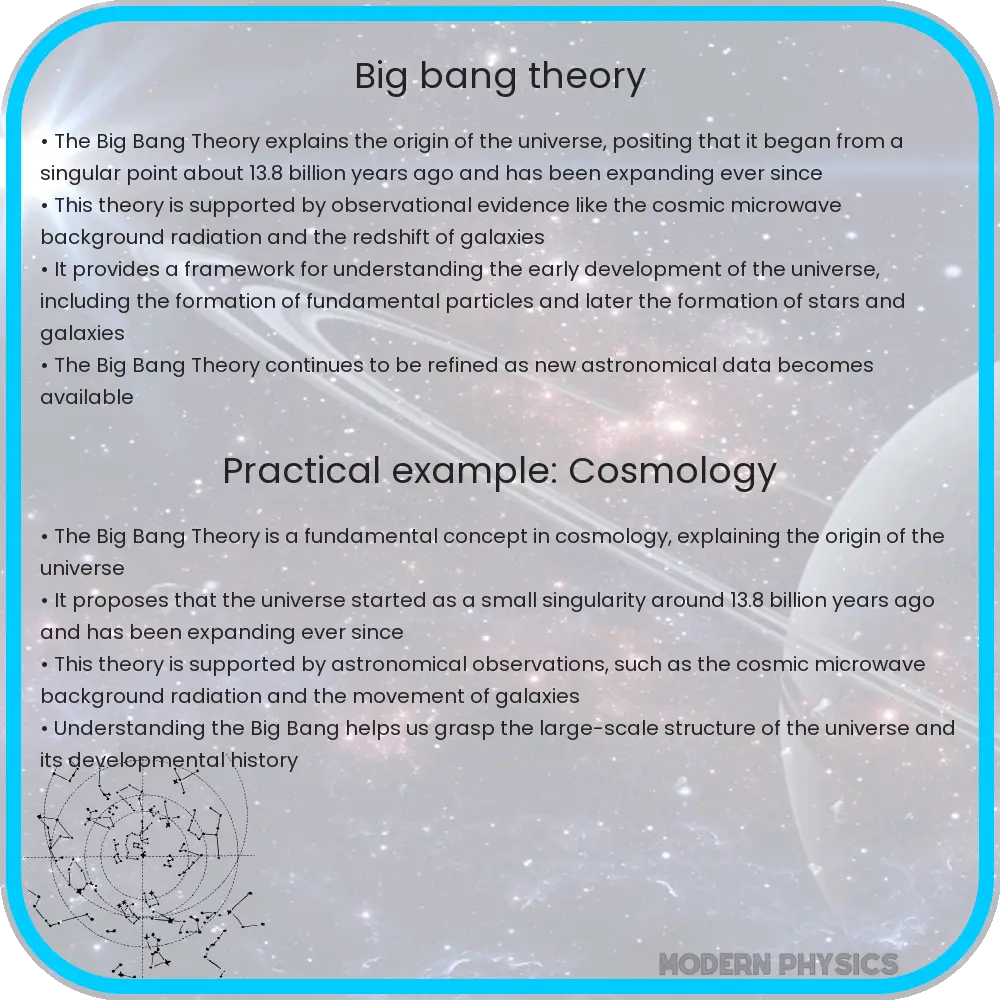Explore the Big Bang Theory, the universe’s origins, its evolution, and the evidence supporting it, from cosmic microwave background radiation to galactic distributions.

The Origins of the Universe: The Big Bang Theory
The Big Bang Theory is the leading explanation about how the universe began. At its simplest, it talks about the universe as we know it starting with a small singularity, then inflating over the next 13.8 billion years to the cosmos that we know today. According to this theory, the universe was once in an extremely hot and dense state which expanded rapidly. This expansion caused the universe to cool and led to its present continuously expanding state.
Evolution of the Universe
Following the initial expansion, the universe cooled sufficiently to allow the formation of subatomic particles, and later simple atoms. Giant clouds of these primordial elements later coalesced through gravity to form stars and galaxies. This period, known as the “cosmic dark ages,” lasted for about 380,000 years. Following this, the first light began to shine through as atoms formed into molecules and stars, leading to the epoch known as the Cosmic Dawn.
Evidence Supporting the Big Bang Theory
- Cosmic Microwave Background Radiation (CMBR): Discovered accidentally by Arno Penzias and Robert Wilson, this is considered the afterglow of the Big Bang. The CMBR is a faint cosmic background radiation filling the universe, which acts as a footprint of the early universe and supports the Big Bang model.
- Galactic Evolution and Distribution: Observations of distant galaxies and quasars show that they are moving away from us, which supports the theory that the universe is expanding. This expansion is uniformly observed in all directions, suggesting that it was the result of the Big Bang.
- Abundance of Light Elements: According to the Big Bang theory, light elements such as Hydrogen (1H), Helium (4He, 3He), and Lithium (7Li) were formed during the first few minutes of the universe. The observed abundance of these elements matches the theoretical predictions, reinforcing the model of the Big Bang.
Further Observations and Studies
As the universe continued to expand and cool, more complex structures began to form. Stars clustered into galaxies, galaxies grouped into clusters, and clusters into superclusters. The distribution and structure of these cosmic entities have been studied extensively to understand the large-scale structure of the universe. Moreover, the role of dark matter and dark energy in shaping the universe has become a significant area of research. Dark matter, which does not emit light or energy, is thought to constitute the majority of the matter in the universe, while dark energy is believed to be responsible for the accelerated expansion of the universe.
Implications of the Big Bang Theory
The Big Bang Theory has profound implications for our understanding of the universe and our place in it. It suggests that the universe has a finite age and that space and time had a beginning. Moreover, it challenges us to understand the conditions of the early universe and the laws of physics that governed its initial moments. The theory is continuously refined and expanded as new astronomical observations are made and as physicists develop new theories to explain the fundamental forces of nature.
Conclusion
The Big Bang Theory remains the most comprehensive and widely accepted explanation for the origin and evolution of the universe. Supported by multiple strands of astronomical evidence, such as the cosmic microwave background radiation, the distribution of galaxies, and the abundance of light elements, the theory provides a coherent framework that explains the past, present, and future of the cosmos. As technology advances and our understanding deepens, future observations and discoveries will undoubtedly refine our view of the universe’s birth and its subsequent evolution. Despite its complexities and mysteries, the Big Bang Theory stands as a testament to human curiosity and our quest to understand our origins.
